Higher National Diploma: Understanding and Leading Change Report
VerifiedAdded on 2022/12/23
|12
|3767
|50
Report
AI Summary
This report provides a comprehensive analysis of change management within organizations, focusing on its impact on strategy and operations. It examines both internal and external drivers of change, including political, economic, social, and technological factors, and how these influence leadership, team dynamics, and individual behaviors. The report explores measures to mitigate the negative effects of change, such as Lewin's change management model, and identifies common barriers to change, including lack of employee involvement and communication. It also delves into various leadership approaches to effectively navigate and implement change, offering insights into how organizations can adapt and thrive in a dynamic environment. The report uses Wilko as a case study to illustrate the concepts, examining its responses to market pressures and technological advancements.
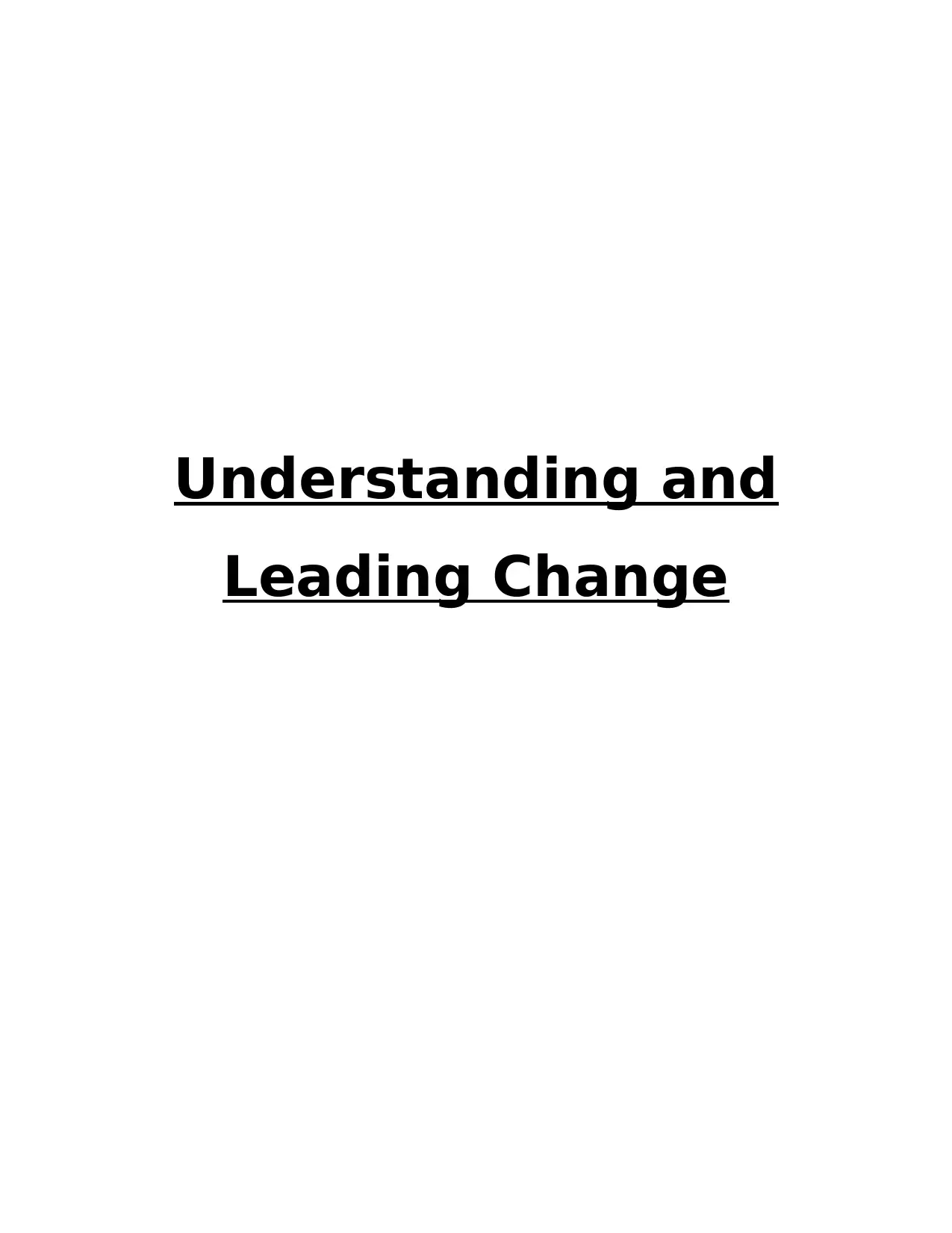
Understanding and
Leading Change
Leading Change
Secure Best Marks with AI Grader
Need help grading? Try our AI Grader for instant feedback on your assignments.
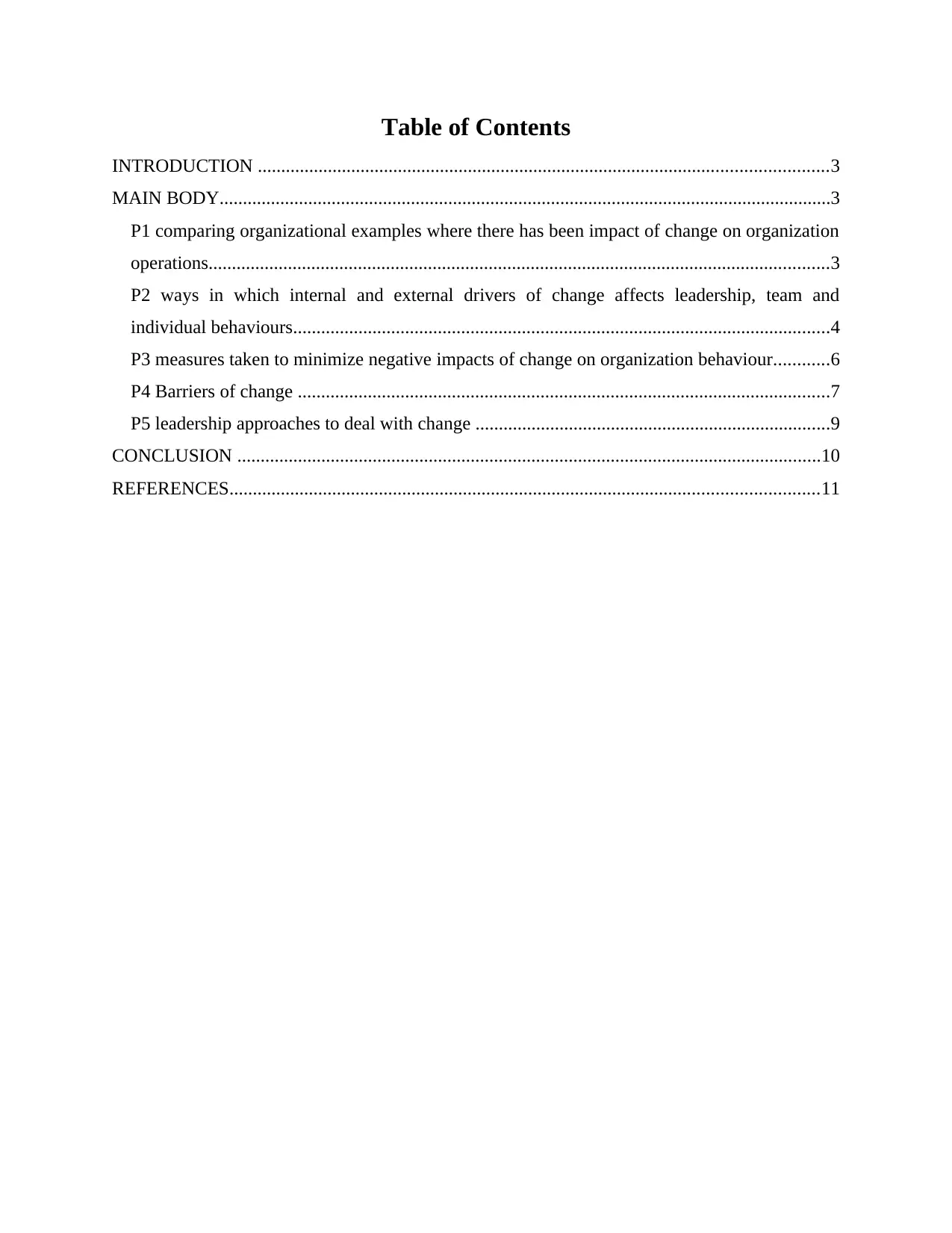
Table of Contents
INTRODUCTION ..........................................................................................................................3
MAIN BODY...................................................................................................................................3
P1 comparing organizational examples where there has been impact of change on organization
operations.....................................................................................................................................3
P2 ways in which internal and external drivers of change affects leadership, team and
individual behaviours...................................................................................................................4
P3 measures taken to minimize negative impacts of change on organization behaviour............6
P4 Barriers of change ..................................................................................................................7
P5 leadership approaches to deal with change ............................................................................9
CONCLUSION .............................................................................................................................10
REFERENCES..............................................................................................................................11
INTRODUCTION ..........................................................................................................................3
MAIN BODY...................................................................................................................................3
P1 comparing organizational examples where there has been impact of change on organization
operations.....................................................................................................................................3
P2 ways in which internal and external drivers of change affects leadership, team and
individual behaviours...................................................................................................................4
P3 measures taken to minimize negative impacts of change on organization behaviour............6
P4 Barriers of change ..................................................................................................................7
P5 leadership approaches to deal with change ............................................................................9
CONCLUSION .............................................................................................................................10
REFERENCES..............................................................................................................................11
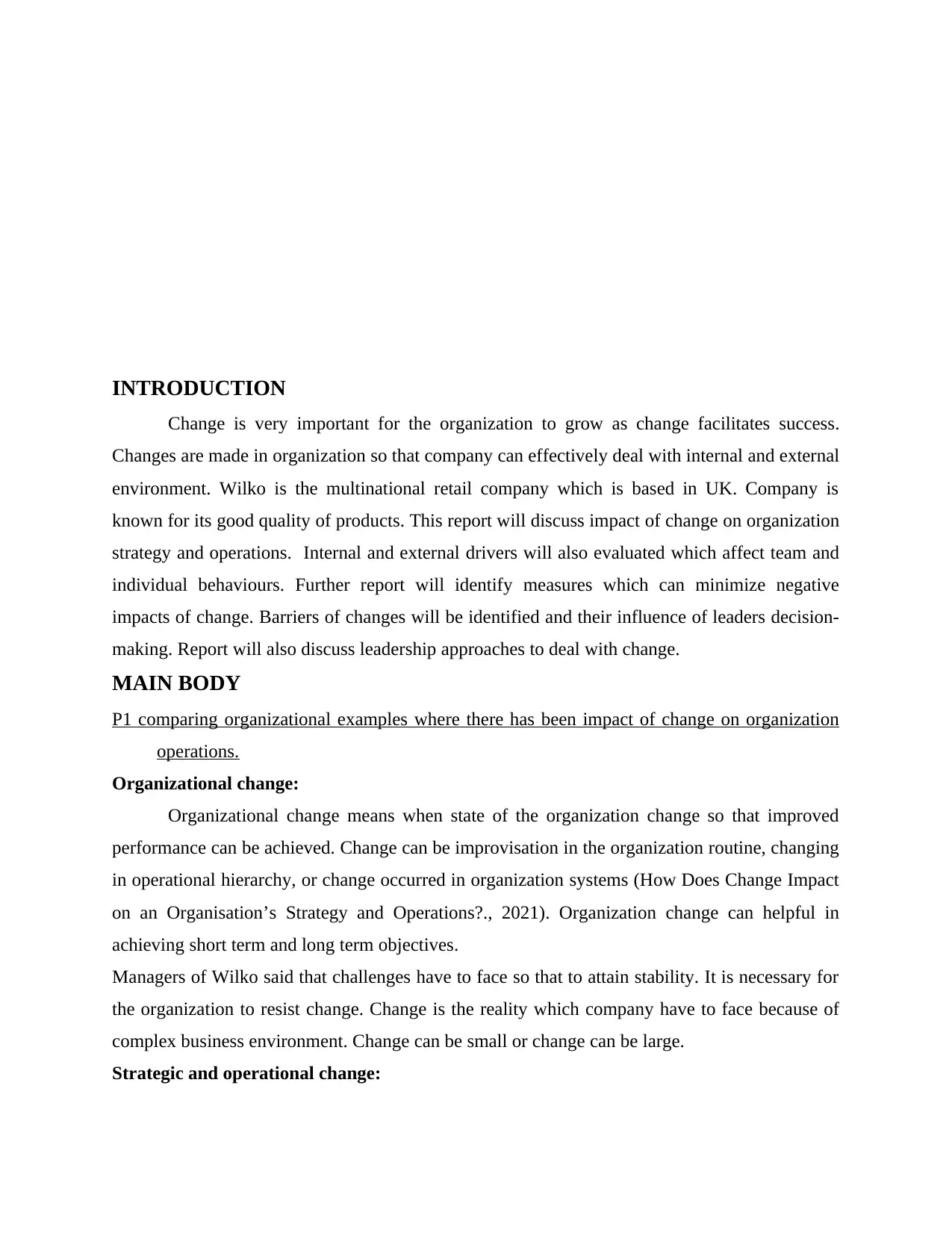
INTRODUCTION
Change is very important for the organization to grow as change facilitates success.
Changes are made in organization so that company can effectively deal with internal and external
environment. Wilko is the multinational retail company which is based in UK. Company is
known for its good quality of products. This report will discuss impact of change on organization
strategy and operations. Internal and external drivers will also evaluated which affect team and
individual behaviours. Further report will identify measures which can minimize negative
impacts of change. Barriers of changes will be identified and their influence of leaders decision-
making. Report will also discuss leadership approaches to deal with change.
MAIN BODY
P1 comparing organizational examples where there has been impact of change on organization
operations.
Organizational change:
Organizational change means when state of the organization change so that improved
performance can be achieved. Change can be improvisation in the organization routine, changing
in operational hierarchy, or change occurred in organization systems (How Does Change Impact
on an Organisation’s Strategy and Operations?., 2021). Organization change can helpful in
achieving short term and long term objectives.
Managers of Wilko said that challenges have to face so that to attain stability. It is necessary for
the organization to resist change. Change is the reality which company have to face because of
complex business environment. Change can be small or change can be large.
Strategic and operational change:
Change is very important for the organization to grow as change facilitates success.
Changes are made in organization so that company can effectively deal with internal and external
environment. Wilko is the multinational retail company which is based in UK. Company is
known for its good quality of products. This report will discuss impact of change on organization
strategy and operations. Internal and external drivers will also evaluated which affect team and
individual behaviours. Further report will identify measures which can minimize negative
impacts of change. Barriers of changes will be identified and their influence of leaders decision-
making. Report will also discuss leadership approaches to deal with change.
MAIN BODY
P1 comparing organizational examples where there has been impact of change on organization
operations.
Organizational change:
Organizational change means when state of the organization change so that improved
performance can be achieved. Change can be improvisation in the organization routine, changing
in operational hierarchy, or change occurred in organization systems (How Does Change Impact
on an Organisation’s Strategy and Operations?., 2021). Organization change can helpful in
achieving short term and long term objectives.
Managers of Wilko said that challenges have to face so that to attain stability. It is necessary for
the organization to resist change. Change is the reality which company have to face because of
complex business environment. Change can be small or change can be large.
Strategic and operational change:
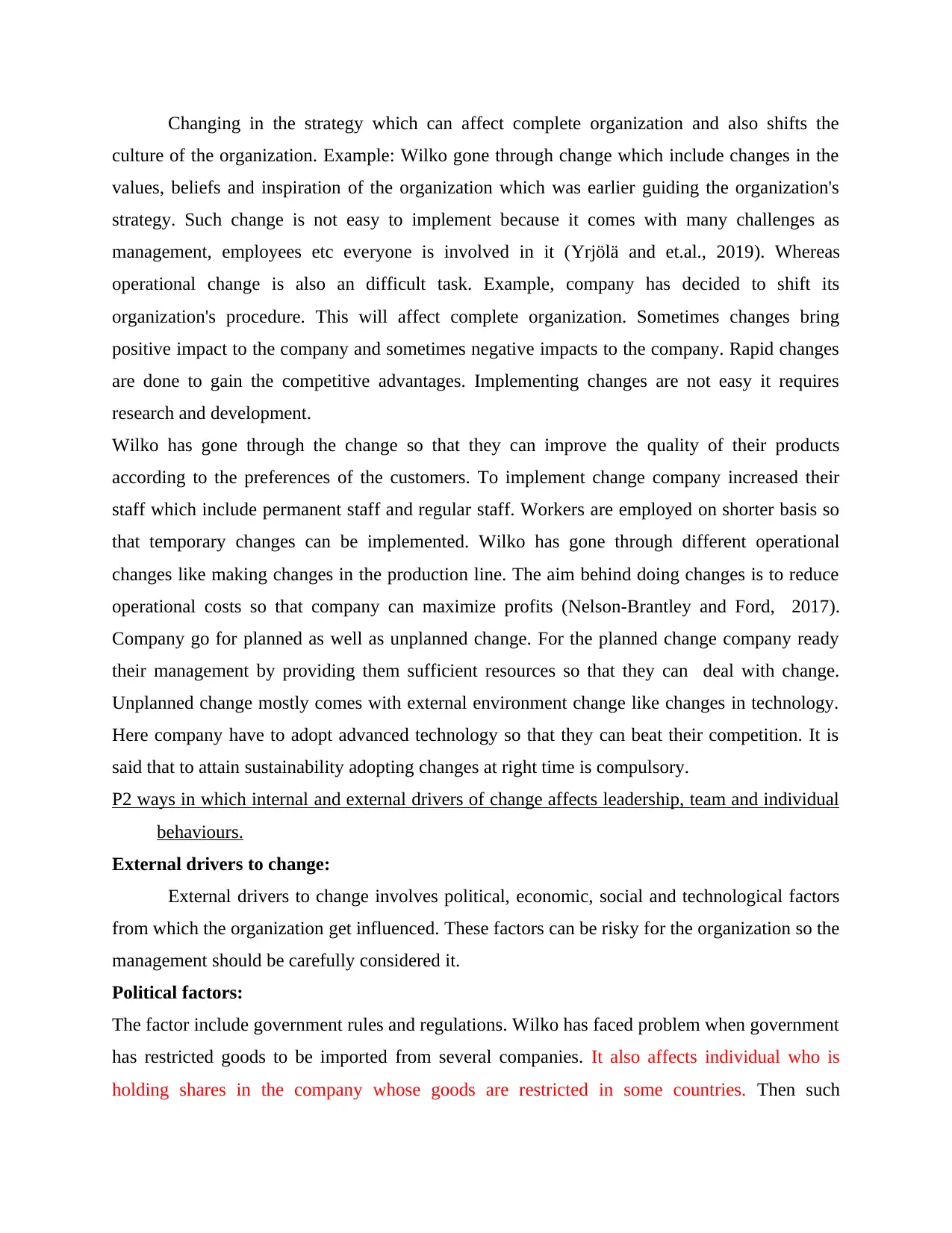
Changing in the strategy which can affect complete organization and also shifts the
culture of the organization. Example: Wilko gone through change which include changes in the
values, beliefs and inspiration of the organization which was earlier guiding the organization's
strategy. Such change is not easy to implement because it comes with many challenges as
management, employees etc everyone is involved in it (Yrjölä and et.al., 2019). Whereas
operational change is also an difficult task. Example, company has decided to shift its
organization's procedure. This will affect complete organization. Sometimes changes bring
positive impact to the company and sometimes negative impacts to the company. Rapid changes
are done to gain the competitive advantages. Implementing changes are not easy it requires
research and development.
Wilko has gone through the change so that they can improve the quality of their products
according to the preferences of the customers. To implement change company increased their
staff which include permanent staff and regular staff. Workers are employed on shorter basis so
that temporary changes can be implemented. Wilko has gone through different operational
changes like making changes in the production line. The aim behind doing changes is to reduce
operational costs so that company can maximize profits (Nelson‐Brantley and Ford, 2017).
Company go for planned as well as unplanned change. For the planned change company ready
their management by providing them sufficient resources so that they can deal with change.
Unplanned change mostly comes with external environment change like changes in technology.
Here company have to adopt advanced technology so that they can beat their competition. It is
said that to attain sustainability adopting changes at right time is compulsory.
P2 ways in which internal and external drivers of change affects leadership, team and individual
behaviours.
External drivers to change:
External drivers to change involves political, economic, social and technological factors
from which the organization get influenced. These factors can be risky for the organization so the
management should be carefully considered it.
Political factors:
The factor include government rules and regulations. Wilko has faced problem when government
has restricted goods to be imported from several companies. It also affects individual who is
holding shares in the company whose goods are restricted in some countries. Then such
culture of the organization. Example: Wilko gone through change which include changes in the
values, beliefs and inspiration of the organization which was earlier guiding the organization's
strategy. Such change is not easy to implement because it comes with many challenges as
management, employees etc everyone is involved in it (Yrjölä and et.al., 2019). Whereas
operational change is also an difficult task. Example, company has decided to shift its
organization's procedure. This will affect complete organization. Sometimes changes bring
positive impact to the company and sometimes negative impacts to the company. Rapid changes
are done to gain the competitive advantages. Implementing changes are not easy it requires
research and development.
Wilko has gone through the change so that they can improve the quality of their products
according to the preferences of the customers. To implement change company increased their
staff which include permanent staff and regular staff. Workers are employed on shorter basis so
that temporary changes can be implemented. Wilko has gone through different operational
changes like making changes in the production line. The aim behind doing changes is to reduce
operational costs so that company can maximize profits (Nelson‐Brantley and Ford, 2017).
Company go for planned as well as unplanned change. For the planned change company ready
their management by providing them sufficient resources so that they can deal with change.
Unplanned change mostly comes with external environment change like changes in technology.
Here company have to adopt advanced technology so that they can beat their competition. It is
said that to attain sustainability adopting changes at right time is compulsory.
P2 ways in which internal and external drivers of change affects leadership, team and individual
behaviours.
External drivers to change:
External drivers to change involves political, economic, social and technological factors
from which the organization get influenced. These factors can be risky for the organization so the
management should be carefully considered it.
Political factors:
The factor include government rules and regulations. Wilko has faced problem when government
has restricted goods to be imported from several companies. It also affects individual who is
holding shares in the company whose goods are restricted in some countries. Then such
Secure Best Marks with AI Grader
Need help grading? Try our AI Grader for instant feedback on your assignments.
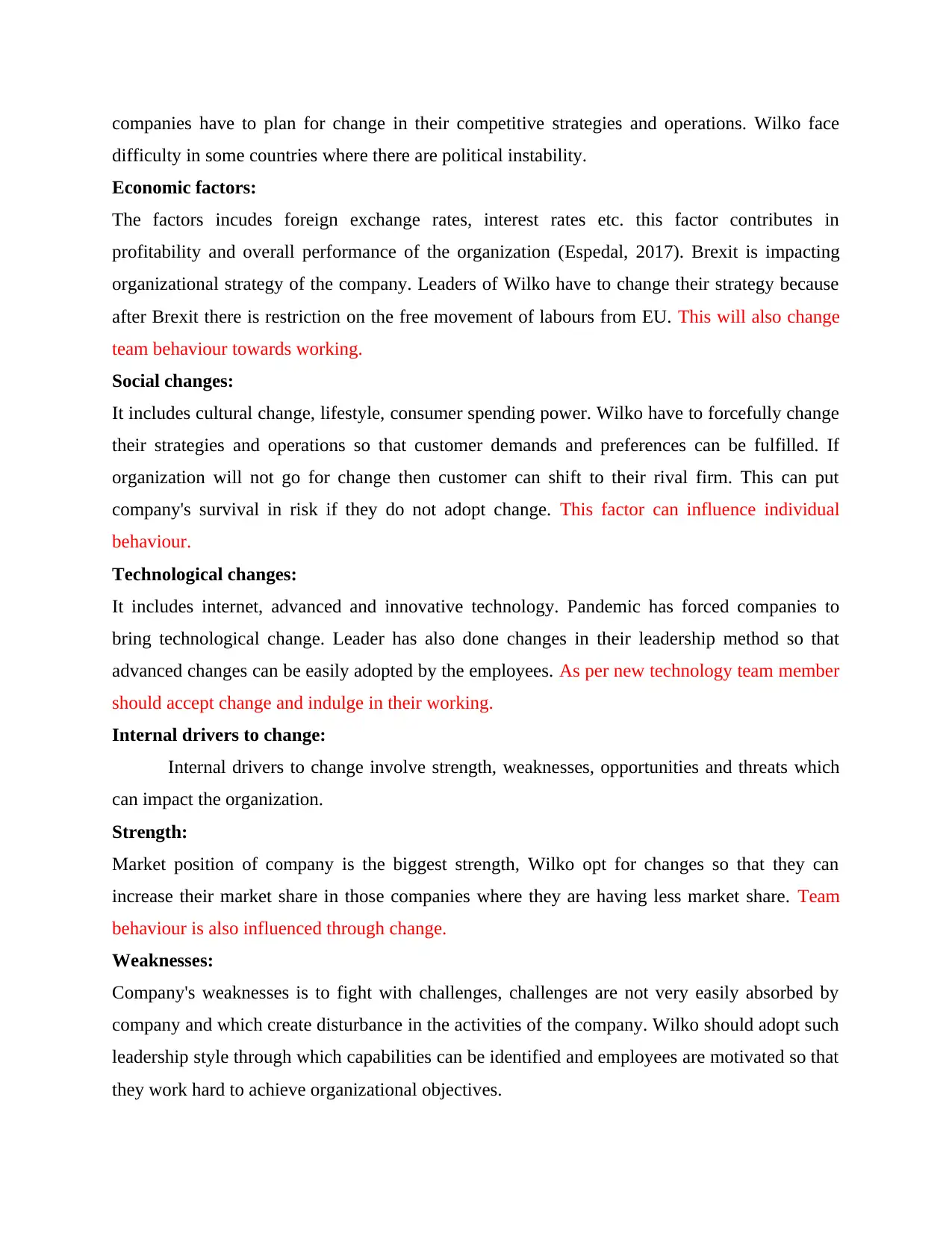
companies have to plan for change in their competitive strategies and operations. Wilko face
difficulty in some countries where there are political instability.
Economic factors:
The factors incudes foreign exchange rates, interest rates etc. this factor contributes in
profitability and overall performance of the organization (Espedal, 2017). Brexit is impacting
organizational strategy of the company. Leaders of Wilko have to change their strategy because
after Brexit there is restriction on the free movement of labours from EU. This will also change
team behaviour towards working.
Social changes:
It includes cultural change, lifestyle, consumer spending power. Wilko have to forcefully change
their strategies and operations so that customer demands and preferences can be fulfilled. If
organization will not go for change then customer can shift to their rival firm. This can put
company's survival in risk if they do not adopt change. This factor can influence individual
behaviour.
Technological changes:
It includes internet, advanced and innovative technology. Pandemic has forced companies to
bring technological change. Leader has also done changes in their leadership method so that
advanced changes can be easily adopted by the employees. As per new technology team member
should accept change and indulge in their working.
Internal drivers to change:
Internal drivers to change involve strength, weaknesses, opportunities and threats which
can impact the organization.
Strength:
Market position of company is the biggest strength, Wilko opt for changes so that they can
increase their market share in those companies where they are having less market share. Team
behaviour is also influenced through change.
Weaknesses:
Company's weaknesses is to fight with challenges, challenges are not very easily absorbed by
company and which create disturbance in the activities of the company. Wilko should adopt such
leadership style through which capabilities can be identified and employees are motivated so that
they work hard to achieve organizational objectives.
difficulty in some countries where there are political instability.
Economic factors:
The factors incudes foreign exchange rates, interest rates etc. this factor contributes in
profitability and overall performance of the organization (Espedal, 2017). Brexit is impacting
organizational strategy of the company. Leaders of Wilko have to change their strategy because
after Brexit there is restriction on the free movement of labours from EU. This will also change
team behaviour towards working.
Social changes:
It includes cultural change, lifestyle, consumer spending power. Wilko have to forcefully change
their strategies and operations so that customer demands and preferences can be fulfilled. If
organization will not go for change then customer can shift to their rival firm. This can put
company's survival in risk if they do not adopt change. This factor can influence individual
behaviour.
Technological changes:
It includes internet, advanced and innovative technology. Pandemic has forced companies to
bring technological change. Leader has also done changes in their leadership method so that
advanced changes can be easily adopted by the employees. As per new technology team member
should accept change and indulge in their working.
Internal drivers to change:
Internal drivers to change involve strength, weaknesses, opportunities and threats which
can impact the organization.
Strength:
Market position of company is the biggest strength, Wilko opt for changes so that they can
increase their market share in those companies where they are having less market share. Team
behaviour is also influenced through change.
Weaknesses:
Company's weaknesses is to fight with challenges, challenges are not very easily absorbed by
company and which create disturbance in the activities of the company. Wilko should adopt such
leadership style through which capabilities can be identified and employees are motivated so that
they work hard to achieve organizational objectives.
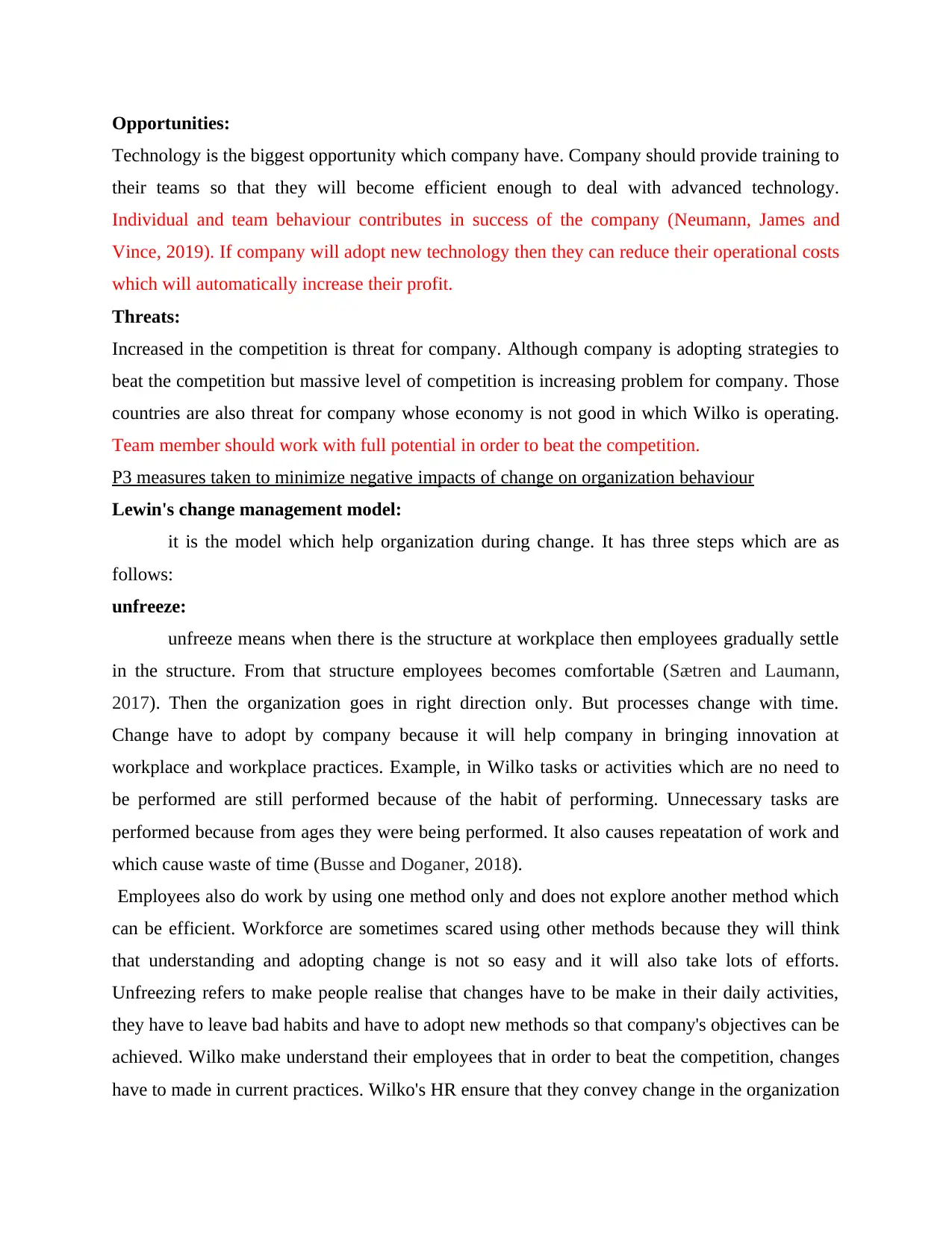
Opportunities:
Technology is the biggest opportunity which company have. Company should provide training to
their teams so that they will become efficient enough to deal with advanced technology.
Individual and team behaviour contributes in success of the company (Neumann, James and
Vince, 2019). If company will adopt new technology then they can reduce their operational costs
which will automatically increase their profit.
Threats:
Increased in the competition is threat for company. Although company is adopting strategies to
beat the competition but massive level of competition is increasing problem for company. Those
countries are also threat for company whose economy is not good in which Wilko is operating.
Team member should work with full potential in order to beat the competition.
P3 measures taken to minimize negative impacts of change on organization behaviour
Lewin's change management model:
it is the model which help organization during change. It has three steps which are as
follows:
unfreeze:
unfreeze means when there is the structure at workplace then employees gradually settle
in the structure. From that structure employees becomes comfortable (Sætren and Laumann,
2017). Then the organization goes in right direction only. But processes change with time.
Change have to adopt by company because it will help company in bringing innovation at
workplace and workplace practices. Example, in Wilko tasks or activities which are no need to
be performed are still performed because of the habit of performing. Unnecessary tasks are
performed because from ages they were being performed. It also causes repeatation of work and
which cause waste of time (Busse and Doganer, 2018).
Employees also do work by using one method only and does not explore another method which
can be efficient. Workforce are sometimes scared using other methods because they will think
that understanding and adopting change is not so easy and it will also take lots of efforts.
Unfreezing refers to make people realise that changes have to be make in their daily activities,
they have to leave bad habits and have to adopt new methods so that company's objectives can be
achieved. Wilko make understand their employees that in order to beat the competition, changes
have to made in current practices. Wilko's HR ensure that they convey change in the organization
Technology is the biggest opportunity which company have. Company should provide training to
their teams so that they will become efficient enough to deal with advanced technology.
Individual and team behaviour contributes in success of the company (Neumann, James and
Vince, 2019). If company will adopt new technology then they can reduce their operational costs
which will automatically increase their profit.
Threats:
Increased in the competition is threat for company. Although company is adopting strategies to
beat the competition but massive level of competition is increasing problem for company. Those
countries are also threat for company whose economy is not good in which Wilko is operating.
Team member should work with full potential in order to beat the competition.
P3 measures taken to minimize negative impacts of change on organization behaviour
Lewin's change management model:
it is the model which help organization during change. It has three steps which are as
follows:
unfreeze:
unfreeze means when there is the structure at workplace then employees gradually settle
in the structure. From that structure employees becomes comfortable (Sætren and Laumann,
2017). Then the organization goes in right direction only. But processes change with time.
Change have to adopt by company because it will help company in bringing innovation at
workplace and workplace practices. Example, in Wilko tasks or activities which are no need to
be performed are still performed because of the habit of performing. Unnecessary tasks are
performed because from ages they were being performed. It also causes repeatation of work and
which cause waste of time (Busse and Doganer, 2018).
Employees also do work by using one method only and does not explore another method which
can be efficient. Workforce are sometimes scared using other methods because they will think
that understanding and adopting change is not so easy and it will also take lots of efforts.
Unfreezing refers to make people realise that changes have to be make in their daily activities,
they have to leave bad habits and have to adopt new methods so that company's objectives can be
achieved. Wilko make understand their employees that in order to beat the competition, changes
have to made in current practices. Wilko's HR ensure that they convey change in the organization
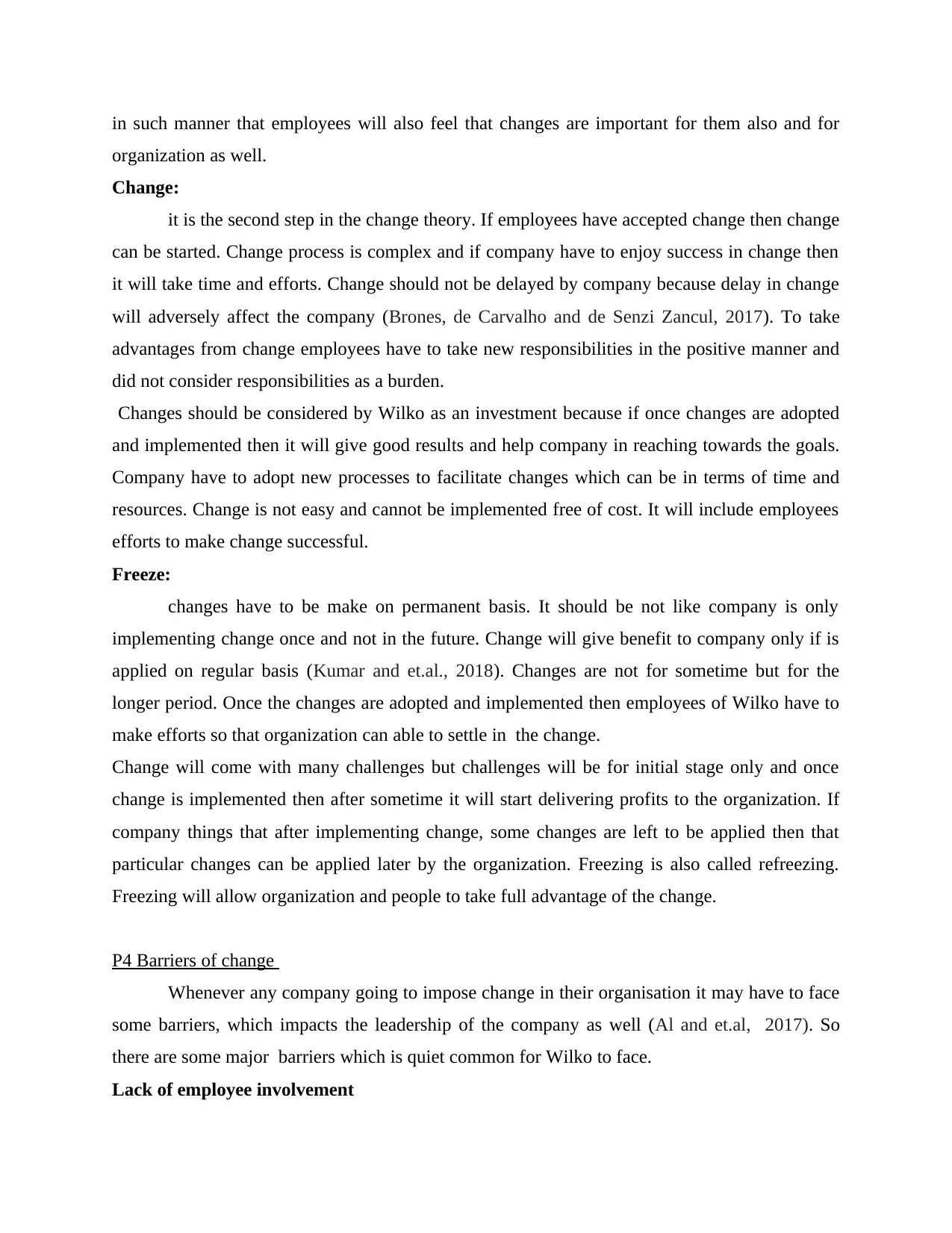
in such manner that employees will also feel that changes are important for them also and for
organization as well.
Change:
it is the second step in the change theory. If employees have accepted change then change
can be started. Change process is complex and if company have to enjoy success in change then
it will take time and efforts. Change should not be delayed by company because delay in change
will adversely affect the company (Brones, de Carvalho and de Senzi Zancul, 2017). To take
advantages from change employees have to take new responsibilities in the positive manner and
did not consider responsibilities as a burden.
Changes should be considered by Wilko as an investment because if once changes are adopted
and implemented then it will give good results and help company in reaching towards the goals.
Company have to adopt new processes to facilitate changes which can be in terms of time and
resources. Change is not easy and cannot be implemented free of cost. It will include employees
efforts to make change successful.
Freeze:
changes have to be make on permanent basis. It should be not like company is only
implementing change once and not in the future. Change will give benefit to company only if is
applied on regular basis (Kumar and et.al., 2018). Changes are not for sometime but for the
longer period. Once the changes are adopted and implemented then employees of Wilko have to
make efforts so that organization can able to settle in the change.
Change will come with many challenges but challenges will be for initial stage only and once
change is implemented then after sometime it will start delivering profits to the organization. If
company things that after implementing change, some changes are left to be applied then that
particular changes can be applied later by the organization. Freezing is also called refreezing.
Freezing will allow organization and people to take full advantage of the change.
P4 Barriers of change
Whenever any company going to impose change in their organisation it may have to face
some barriers, which impacts the leadership of the company as well (Al and et.al, 2017). So
there are some major barriers which is quiet common for Wilko to face.
Lack of employee involvement
organization as well.
Change:
it is the second step in the change theory. If employees have accepted change then change
can be started. Change process is complex and if company have to enjoy success in change then
it will take time and efforts. Change should not be delayed by company because delay in change
will adversely affect the company (Brones, de Carvalho and de Senzi Zancul, 2017). To take
advantages from change employees have to take new responsibilities in the positive manner and
did not consider responsibilities as a burden.
Changes should be considered by Wilko as an investment because if once changes are adopted
and implemented then it will give good results and help company in reaching towards the goals.
Company have to adopt new processes to facilitate changes which can be in terms of time and
resources. Change is not easy and cannot be implemented free of cost. It will include employees
efforts to make change successful.
Freeze:
changes have to be make on permanent basis. It should be not like company is only
implementing change once and not in the future. Change will give benefit to company only if is
applied on regular basis (Kumar and et.al., 2018). Changes are not for sometime but for the
longer period. Once the changes are adopted and implemented then employees of Wilko have to
make efforts so that organization can able to settle in the change.
Change will come with many challenges but challenges will be for initial stage only and once
change is implemented then after sometime it will start delivering profits to the organization. If
company things that after implementing change, some changes are left to be applied then that
particular changes can be applied later by the organization. Freezing is also called refreezing.
Freezing will allow organization and people to take full advantage of the change.
P4 Barriers of change
Whenever any company going to impose change in their organisation it may have to face
some barriers, which impacts the leadership of the company as well (Al and et.al, 2017). So
there are some major barriers which is quiet common for Wilko to face.
Lack of employee involvement
Paraphrase This Document
Need a fresh take? Get an instant paraphrase of this document with our AI Paraphraser
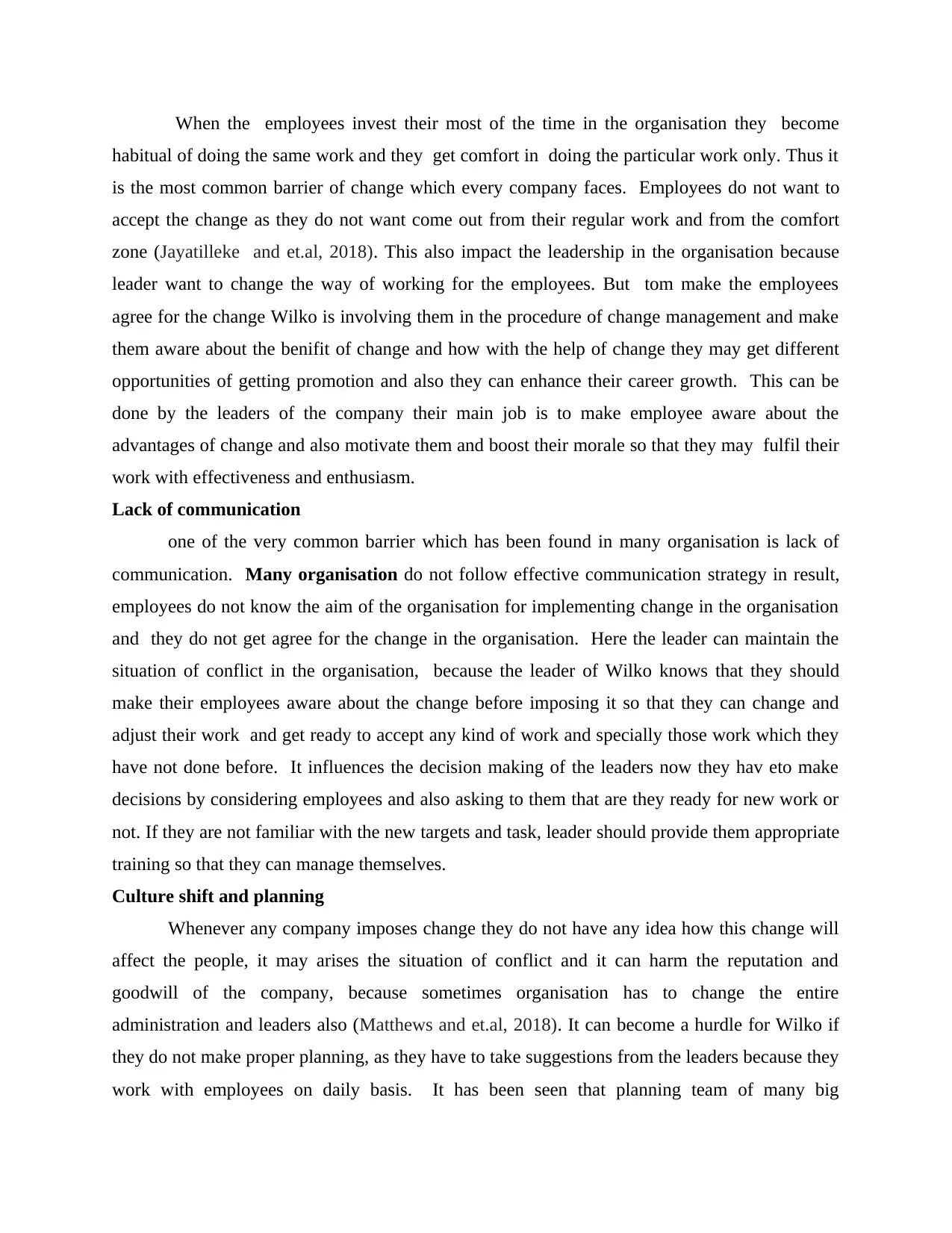
When the employees invest their most of the time in the organisation they become
habitual of doing the same work and they get comfort in doing the particular work only. Thus it
is the most common barrier of change which every company faces. Employees do not want to
accept the change as they do not want come out from their regular work and from the comfort
zone (Jayatilleke and et.al, 2018). This also impact the leadership in the organisation because
leader want to change the way of working for the employees. But tom make the employees
agree for the change Wilko is involving them in the procedure of change management and make
them aware about the benifit of change and how with the help of change they may get different
opportunities of getting promotion and also they can enhance their career growth. This can be
done by the leaders of the company their main job is to make employee aware about the
advantages of change and also motivate them and boost their morale so that they may fulfil their
work with effectiveness and enthusiasm.
Lack of communication
one of the very common barrier which has been found in many organisation is lack of
communication. Many organisation do not follow effective communication strategy in result,
employees do not know the aim of the organisation for implementing change in the organisation
and they do not get agree for the change in the organisation. Here the leader can maintain the
situation of conflict in the organisation, because the leader of Wilko knows that they should
make their employees aware about the change before imposing it so that they can change and
adjust their work and get ready to accept any kind of work and specially those work which they
have not done before. It influences the decision making of the leaders now they hav eto make
decisions by considering employees and also asking to them that are they ready for new work or
not. If they are not familiar with the new targets and task, leader should provide them appropriate
training so that they can manage themselves.
Culture shift and planning
Whenever any company imposes change they do not have any idea how this change will
affect the people, it may arises the situation of conflict and it can harm the reputation and
goodwill of the company, because sometimes organisation has to change the entire
administration and leaders also (Matthews and et.al, 2018). It can become a hurdle for Wilko if
they do not make proper planning, as they have to take suggestions from the leaders because they
work with employees on daily basis. It has been seen that planning team of many big
habitual of doing the same work and they get comfort in doing the particular work only. Thus it
is the most common barrier of change which every company faces. Employees do not want to
accept the change as they do not want come out from their regular work and from the comfort
zone (Jayatilleke and et.al, 2018). This also impact the leadership in the organisation because
leader want to change the way of working for the employees. But tom make the employees
agree for the change Wilko is involving them in the procedure of change management and make
them aware about the benifit of change and how with the help of change they may get different
opportunities of getting promotion and also they can enhance their career growth. This can be
done by the leaders of the company their main job is to make employee aware about the
advantages of change and also motivate them and boost their morale so that they may fulfil their
work with effectiveness and enthusiasm.
Lack of communication
one of the very common barrier which has been found in many organisation is lack of
communication. Many organisation do not follow effective communication strategy in result,
employees do not know the aim of the organisation for implementing change in the organisation
and they do not get agree for the change in the organisation. Here the leader can maintain the
situation of conflict in the organisation, because the leader of Wilko knows that they should
make their employees aware about the change before imposing it so that they can change and
adjust their work and get ready to accept any kind of work and specially those work which they
have not done before. It influences the decision making of the leaders now they hav eto make
decisions by considering employees and also asking to them that are they ready for new work or
not. If they are not familiar with the new targets and task, leader should provide them appropriate
training so that they can manage themselves.
Culture shift and planning
Whenever any company imposes change they do not have any idea how this change will
affect the people, it may arises the situation of conflict and it can harm the reputation and
goodwill of the company, because sometimes organisation has to change the entire
administration and leaders also (Matthews and et.al, 2018). It can become a hurdle for Wilko if
they do not make proper planning, as they have to take suggestions from the leaders because they
work with employees on daily basis. It has been seen that planning team of many big
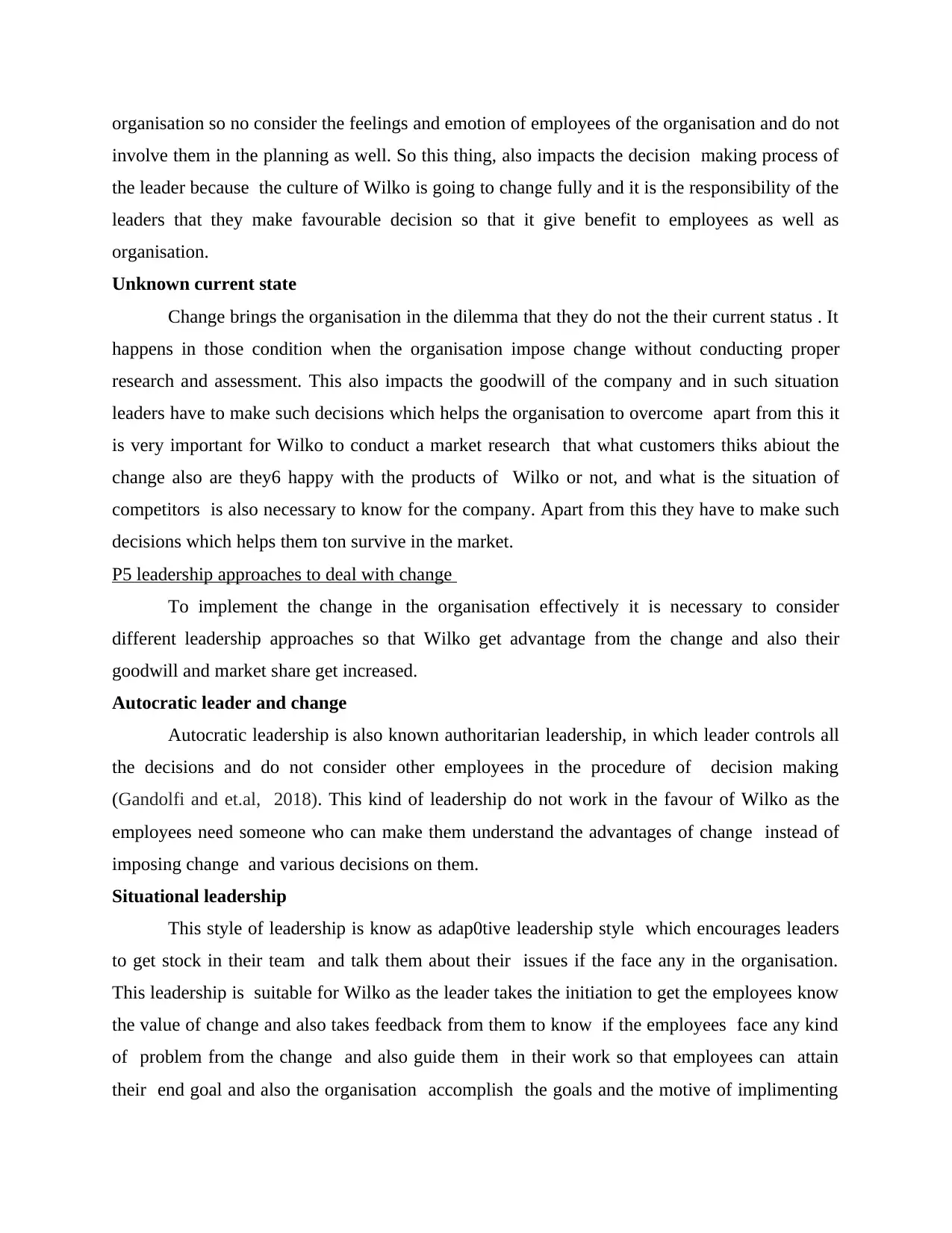
organisation so no consider the feelings and emotion of employees of the organisation and do not
involve them in the planning as well. So this thing, also impacts the decision making process of
the leader because the culture of Wilko is going to change fully and it is the responsibility of the
leaders that they make favourable decision so that it give benefit to employees as well as
organisation.
Unknown current state
Change brings the organisation in the dilemma that they do not the their current status . It
happens in those condition when the organisation impose change without conducting proper
research and assessment. This also impacts the goodwill of the company and in such situation
leaders have to make such decisions which helps the organisation to overcome apart from this it
is very important for Wilko to conduct a market research that what customers thiks abiout the
change also are they6 happy with the products of Wilko or not, and what is the situation of
competitors is also necessary to know for the company. Apart from this they have to make such
decisions which helps them ton survive in the market.
P5 leadership approaches to deal with change
To implement the change in the organisation effectively it is necessary to consider
different leadership approaches so that Wilko get advantage from the change and also their
goodwill and market share get increased.
Autocratic leader and change
Autocratic leadership is also known authoritarian leadership, in which leader controls all
the decisions and do not consider other employees in the procedure of decision making
(Gandolfi and et.al, 2018). This kind of leadership do not work in the favour of Wilko as the
employees need someone who can make them understand the advantages of change instead of
imposing change and various decisions on them.
Situational leadership
This style of leadership is know as adap0tive leadership style which encourages leaders
to get stock in their team and talk them about their issues if the face any in the organisation.
This leadership is suitable for Wilko as the leader takes the initiation to get the employees know
the value of change and also takes feedback from them to know if the employees face any kind
of problem from the change and also guide them in their work so that employees can attain
their end goal and also the organisation accomplish the goals and the motive of implimenting
involve them in the planning as well. So this thing, also impacts the decision making process of
the leader because the culture of Wilko is going to change fully and it is the responsibility of the
leaders that they make favourable decision so that it give benefit to employees as well as
organisation.
Unknown current state
Change brings the organisation in the dilemma that they do not the their current status . It
happens in those condition when the organisation impose change without conducting proper
research and assessment. This also impacts the goodwill of the company and in such situation
leaders have to make such decisions which helps the organisation to overcome apart from this it
is very important for Wilko to conduct a market research that what customers thiks abiout the
change also are they6 happy with the products of Wilko or not, and what is the situation of
competitors is also necessary to know for the company. Apart from this they have to make such
decisions which helps them ton survive in the market.
P5 leadership approaches to deal with change
To implement the change in the organisation effectively it is necessary to consider
different leadership approaches so that Wilko get advantage from the change and also their
goodwill and market share get increased.
Autocratic leader and change
Autocratic leadership is also known authoritarian leadership, in which leader controls all
the decisions and do not consider other employees in the procedure of decision making
(Gandolfi and et.al, 2018). This kind of leadership do not work in the favour of Wilko as the
employees need someone who can make them understand the advantages of change instead of
imposing change and various decisions on them.
Situational leadership
This style of leadership is know as adap0tive leadership style which encourages leaders
to get stock in their team and talk them about their issues if the face any in the organisation.
This leadership is suitable for Wilko as the leader takes the initiation to get the employees know
the value of change and also takes feedback from them to know if the employees face any kind
of problem from the change and also guide them in their work so that employees can attain
their end goal and also the organisation accomplish the goals and the motive of implimenting
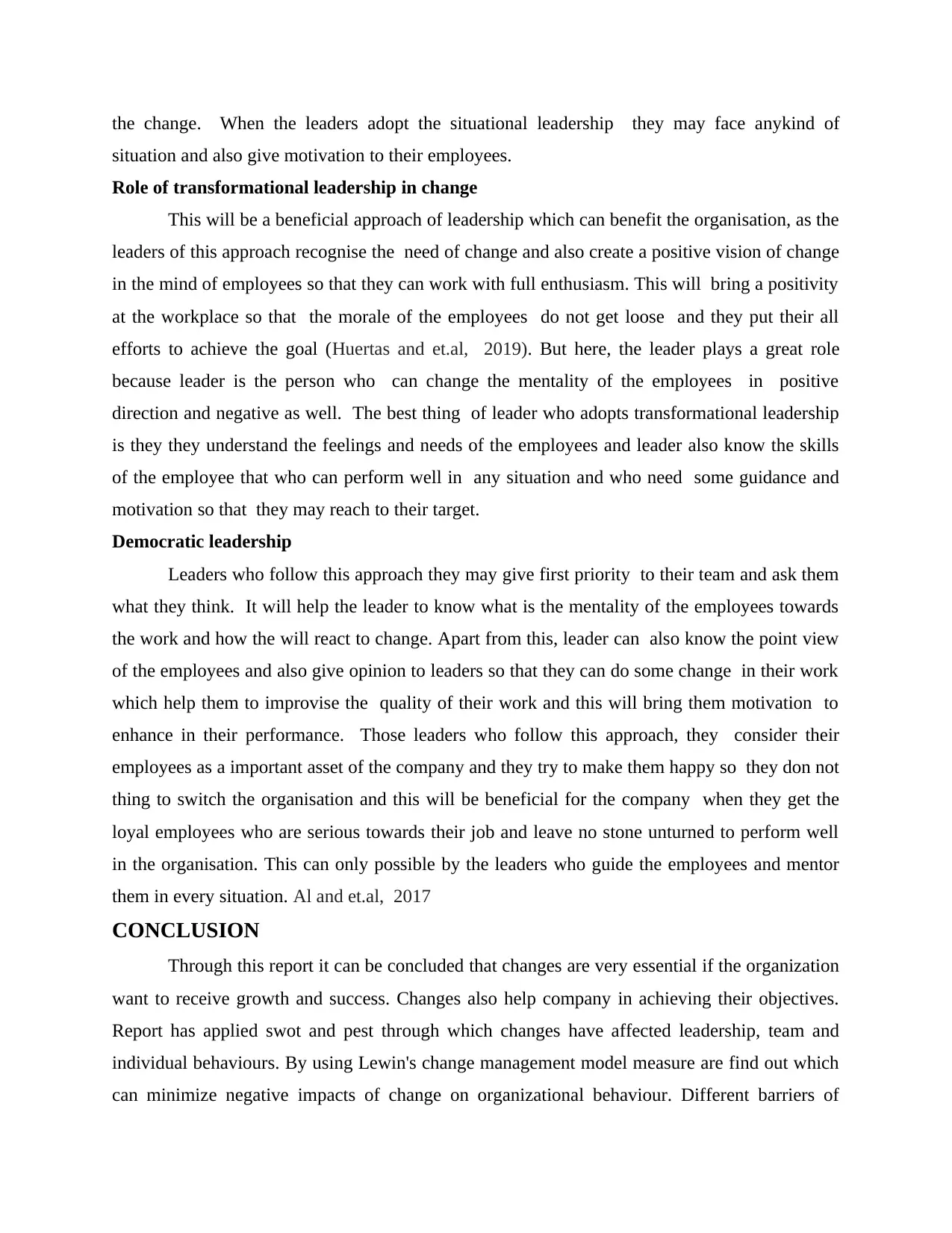
the change. When the leaders adopt the situational leadership they may face anykind of
situation and also give motivation to their employees.
Role of transformational leadership in change
This will be a beneficial approach of leadership which can benefit the organisation, as the
leaders of this approach recognise the need of change and also create a positive vision of change
in the mind of employees so that they can work with full enthusiasm. This will bring a positivity
at the workplace so that the morale of the employees do not get loose and they put their all
efforts to achieve the goal (Huertas and et.al, 2019). But here, the leader plays a great role
because leader is the person who can change the mentality of the employees in positive
direction and negative as well. The best thing of leader who adopts transformational leadership
is they they understand the feelings and needs of the employees and leader also know the skills
of the employee that who can perform well in any situation and who need some guidance and
motivation so that they may reach to their target.
Democratic leadership
Leaders who follow this approach they may give first priority to their team and ask them
what they think. It will help the leader to know what is the mentality of the employees towards
the work and how the will react to change. Apart from this, leader can also know the point view
of the employees and also give opinion to leaders so that they can do some change in their work
which help them to improvise the quality of their work and this will bring them motivation to
enhance in their performance. Those leaders who follow this approach, they consider their
employees as a important asset of the company and they try to make them happy so they don not
thing to switch the organisation and this will be beneficial for the company when they get the
loyal employees who are serious towards their job and leave no stone unturned to perform well
in the organisation. This can only possible by the leaders who guide the employees and mentor
them in every situation. Al and et.al, 2017
CONCLUSION
Through this report it can be concluded that changes are very essential if the organization
want to receive growth and success. Changes also help company in achieving their objectives.
Report has applied swot and pest through which changes have affected leadership, team and
individual behaviours. By using Lewin's change management model measure are find out which
can minimize negative impacts of change on organizational behaviour. Different barriers of
situation and also give motivation to their employees.
Role of transformational leadership in change
This will be a beneficial approach of leadership which can benefit the organisation, as the
leaders of this approach recognise the need of change and also create a positive vision of change
in the mind of employees so that they can work with full enthusiasm. This will bring a positivity
at the workplace so that the morale of the employees do not get loose and they put their all
efforts to achieve the goal (Huertas and et.al, 2019). But here, the leader plays a great role
because leader is the person who can change the mentality of the employees in positive
direction and negative as well. The best thing of leader who adopts transformational leadership
is they they understand the feelings and needs of the employees and leader also know the skills
of the employee that who can perform well in any situation and who need some guidance and
motivation so that they may reach to their target.
Democratic leadership
Leaders who follow this approach they may give first priority to their team and ask them
what they think. It will help the leader to know what is the mentality of the employees towards
the work and how the will react to change. Apart from this, leader can also know the point view
of the employees and also give opinion to leaders so that they can do some change in their work
which help them to improvise the quality of their work and this will bring them motivation to
enhance in their performance. Those leaders who follow this approach, they consider their
employees as a important asset of the company and they try to make them happy so they don not
thing to switch the organisation and this will be beneficial for the company when they get the
loyal employees who are serious towards their job and leave no stone unturned to perform well
in the organisation. This can only possible by the leaders who guide the employees and mentor
them in every situation. Al and et.al, 2017
CONCLUSION
Through this report it can be concluded that changes are very essential if the organization
want to receive growth and success. Changes also help company in achieving their objectives.
Report has applied swot and pest through which changes have affected leadership, team and
individual behaviours. By using Lewin's change management model measure are find out which
can minimize negative impacts of change on organizational behaviour. Different barriers of
Secure Best Marks with AI Grader
Need help grading? Try our AI Grader for instant feedback on your assignments.
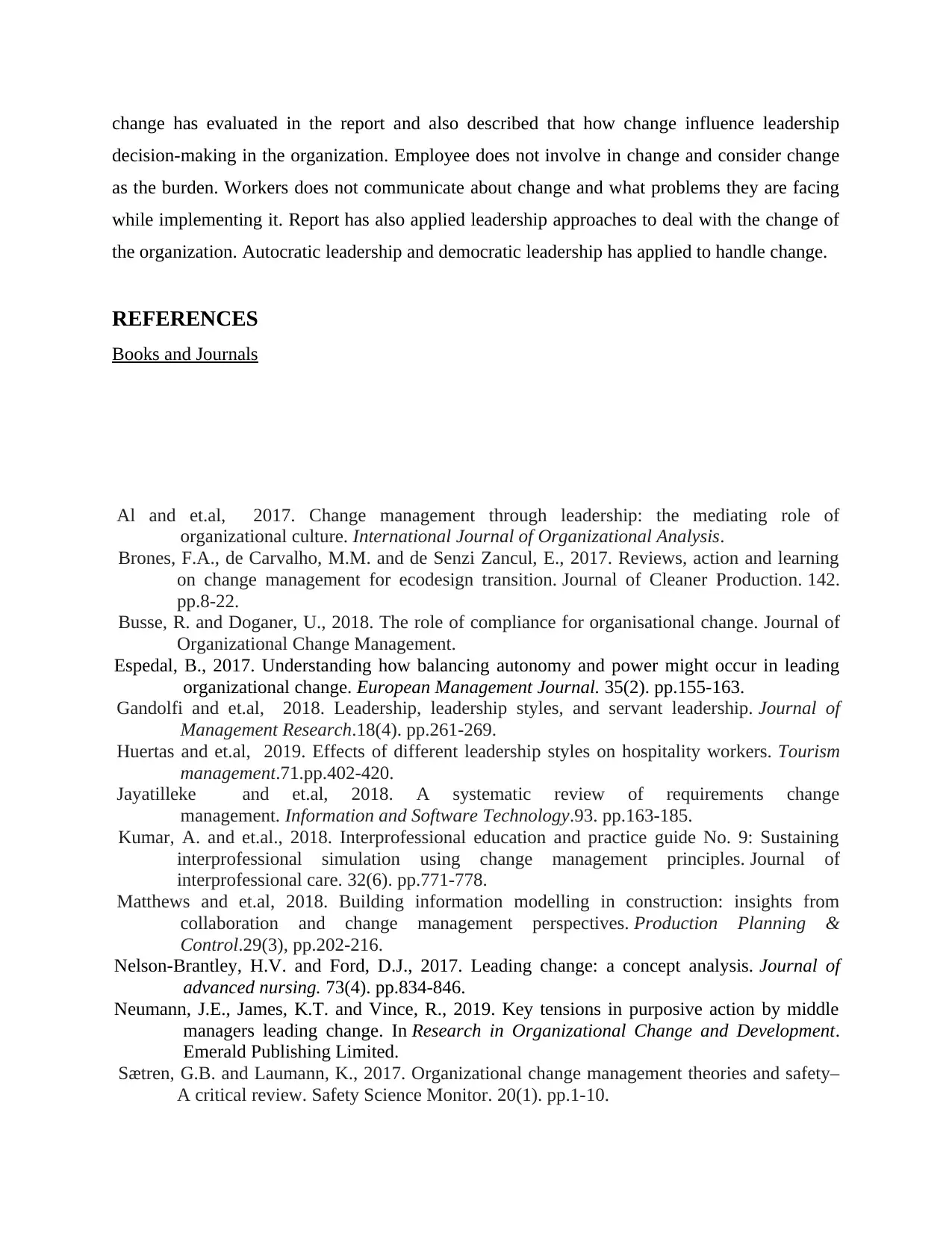
change has evaluated in the report and also described that how change influence leadership
decision-making in the organization. Employee does not involve in change and consider change
as the burden. Workers does not communicate about change and what problems they are facing
while implementing it. Report has also applied leadership approaches to deal with the change of
the organization. Autocratic leadership and democratic leadership has applied to handle change.
REFERENCES
Books and Journals
Al and et.al, 2017. Change management through leadership: the mediating role of
organizational culture. International Journal of Organizational Analysis.
Brones, F.A., de Carvalho, M.M. and de Senzi Zancul, E., 2017. Reviews, action and learning
on change management for ecodesign transition. Journal of Cleaner Production. 142.
pp.8-22.
Busse, R. and Doganer, U., 2018. The role of compliance for organisational change. Journal of
Organizational Change Management.
Espedal, B., 2017. Understanding how balancing autonomy and power might occur in leading
organizational change. European Management Journal. 35(2). pp.155-163.
Gandolfi and et.al, 2018. Leadership, leadership styles, and servant leadership. Journal of
Management Research.18(4). pp.261-269.
Huertas and et.al, 2019. Effects of different leadership styles on hospitality workers. Tourism
management.71.pp.402-420.
Jayatilleke and et.al, 2018. A systematic review of requirements change
management. Information and Software Technology.93. pp.163-185.
Kumar, A. and et.al., 2018. Interprofessional education and practice guide No. 9: Sustaining
interprofessional simulation using change management principles. Journal of
interprofessional care. 32(6). pp.771-778.
Matthews and et.al, 2018. Building information modelling in construction: insights from
collaboration and change management perspectives. Production Planning &
Control.29(3), pp.202-216.
Nelson‐Brantley, H.V. and Ford, D.J., 2017. Leading change: a concept analysis. Journal of
advanced nursing. 73(4). pp.834-846.
Neumann, J.E., James, K.T. and Vince, R., 2019. Key tensions in purposive action by middle
managers leading change. In Research in Organizational Change and Development.
Emerald Publishing Limited.
Sætren, G.B. and Laumann, K., 2017. Organizational change management theories and safety–
A critical review. Safety Science Monitor. 20(1). pp.1-10.
decision-making in the organization. Employee does not involve in change and consider change
as the burden. Workers does not communicate about change and what problems they are facing
while implementing it. Report has also applied leadership approaches to deal with the change of
the organization. Autocratic leadership and democratic leadership has applied to handle change.
REFERENCES
Books and Journals
Al and et.al, 2017. Change management through leadership: the mediating role of
organizational culture. International Journal of Organizational Analysis.
Brones, F.A., de Carvalho, M.M. and de Senzi Zancul, E., 2017. Reviews, action and learning
on change management for ecodesign transition. Journal of Cleaner Production. 142.
pp.8-22.
Busse, R. and Doganer, U., 2018. The role of compliance for organisational change. Journal of
Organizational Change Management.
Espedal, B., 2017. Understanding how balancing autonomy and power might occur in leading
organizational change. European Management Journal. 35(2). pp.155-163.
Gandolfi and et.al, 2018. Leadership, leadership styles, and servant leadership. Journal of
Management Research.18(4). pp.261-269.
Huertas and et.al, 2019. Effects of different leadership styles on hospitality workers. Tourism
management.71.pp.402-420.
Jayatilleke and et.al, 2018. A systematic review of requirements change
management. Information and Software Technology.93. pp.163-185.
Kumar, A. and et.al., 2018. Interprofessional education and practice guide No. 9: Sustaining
interprofessional simulation using change management principles. Journal of
interprofessional care. 32(6). pp.771-778.
Matthews and et.al, 2018. Building information modelling in construction: insights from
collaboration and change management perspectives. Production Planning &
Control.29(3), pp.202-216.
Nelson‐Brantley, H.V. and Ford, D.J., 2017. Leading change: a concept analysis. Journal of
advanced nursing. 73(4). pp.834-846.
Neumann, J.E., James, K.T. and Vince, R., 2019. Key tensions in purposive action by middle
managers leading change. In Research in Organizational Change and Development.
Emerald Publishing Limited.
Sætren, G.B. and Laumann, K., 2017. Organizational change management theories and safety–
A critical review. Safety Science Monitor. 20(1). pp.1-10.
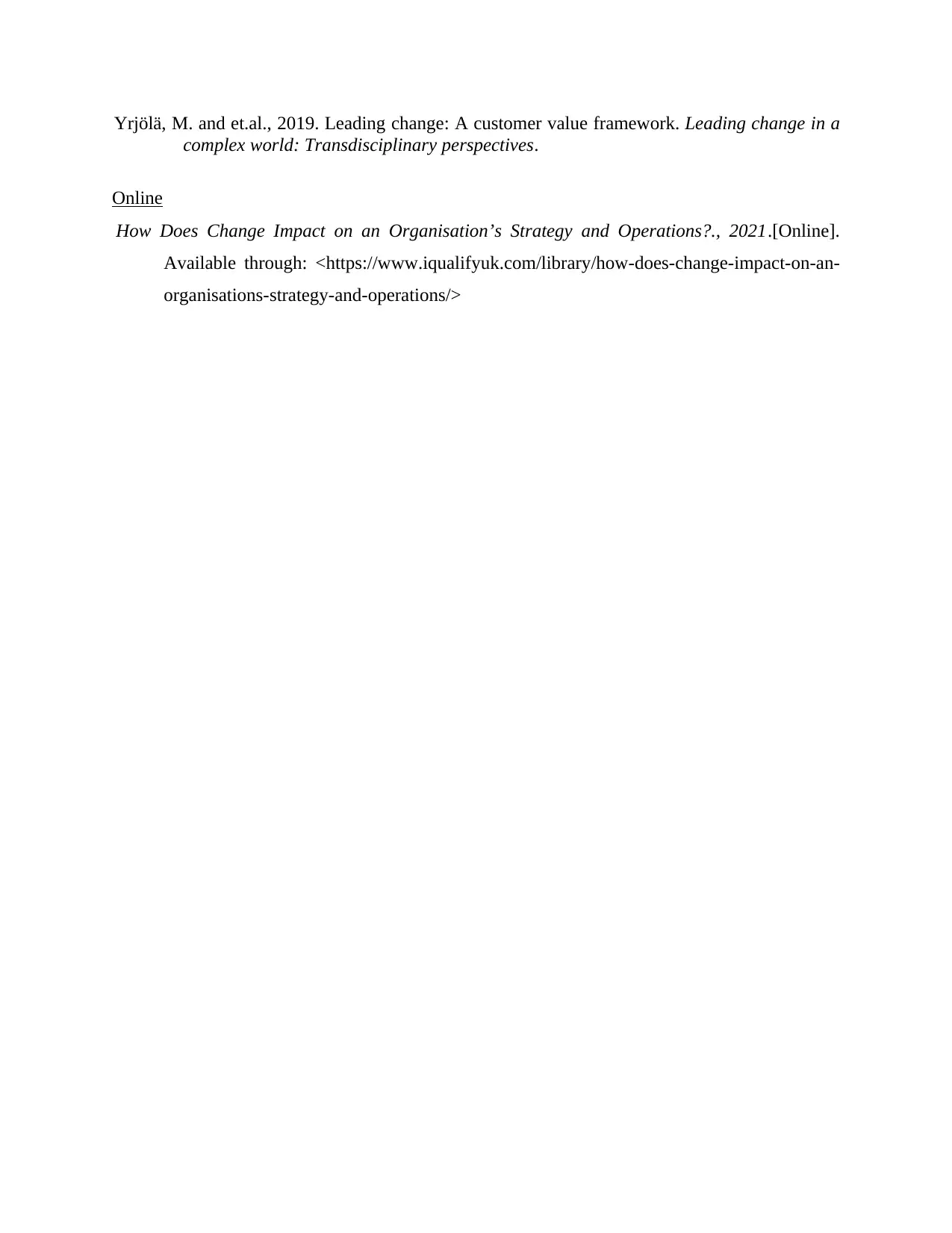
Yrjölä, M. and et.al., 2019. Leading change: A customer value framework. Leading change in a
complex world: Transdisciplinary perspectives.
Online
How Does Change Impact on an Organisation’s Strategy and Operations?., 2021.[Online].
Available through: <https://www.iqualifyuk.com/library/how-does-change-impact-on-an-
organisations-strategy-and-operations/>
complex world: Transdisciplinary perspectives.
Online
How Does Change Impact on an Organisation’s Strategy and Operations?., 2021.[Online].
Available through: <https://www.iqualifyuk.com/library/how-does-change-impact-on-an-
organisations-strategy-and-operations/>
1 out of 12
Related Documents
Your All-in-One AI-Powered Toolkit for Academic Success.
+13062052269
info@desklib.com
Available 24*7 on WhatsApp / Email
![[object Object]](/_next/static/media/star-bottom.7253800d.svg)
Unlock your academic potential
© 2024 | Zucol Services PVT LTD | All rights reserved.




